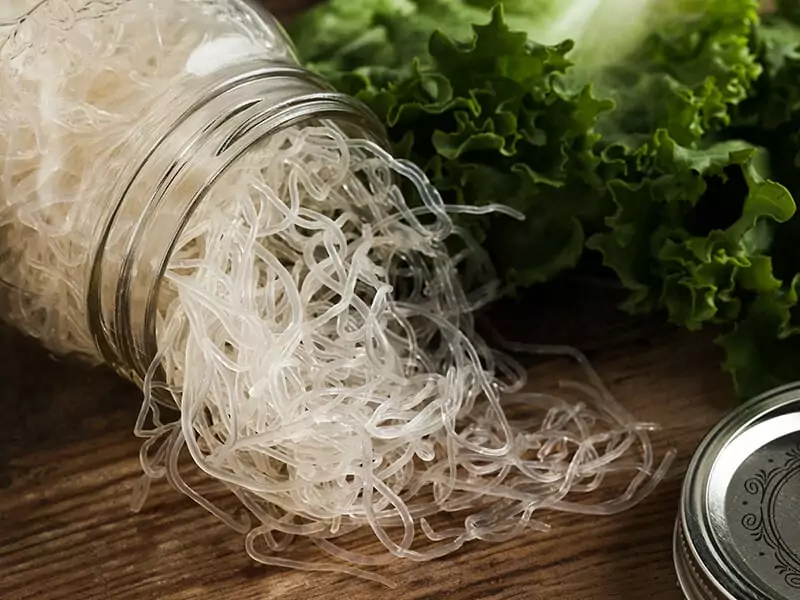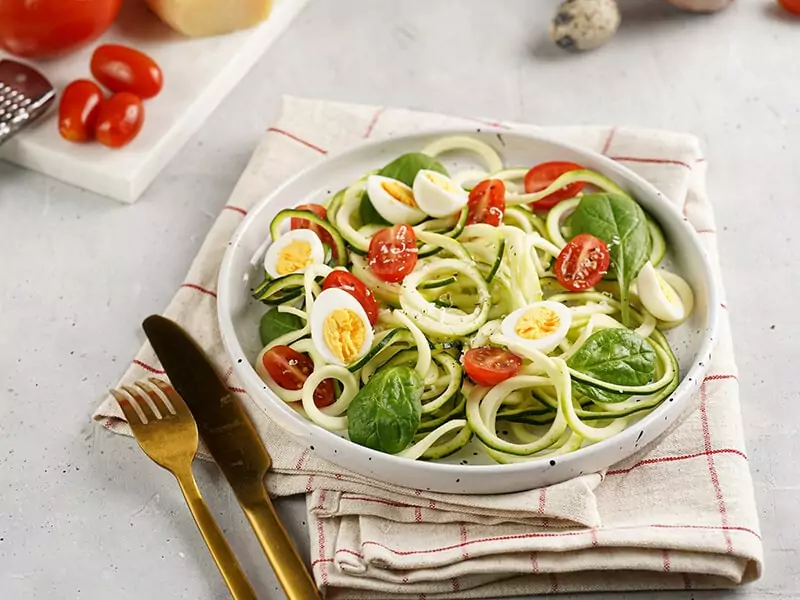Finding substitutes for ramen noodles might be a solution for those who are too addicted to this food. The truth is that it’s hard to give up the appealing taste and aroma of these foods. Freshly-made ramen bowls at restaurants are excellent, but the instant ones are real keepers.
No doubt that ramen noodles are a tough rival to compete with, but you can’t only stick around with one option. Check out the substitute below if ramen noodles are sold out at nearby stores. From udon and soba to wonton noodles, this list got you all covered.

A Quick Walkthrough Of Ramen Noodles
It goes without saying that ramen noodles have a solid fan base in the US due to their convenience and low prices. The high consumption rate of this snack is evident in the availability in any supermarket and the growth of ramen houses.
With Chinese-style wheat noodles, meat, and vegetables, ramen is a Japanese three-in-one meal. All the ingredients are in harmony with delicious broth made from chicken or pork bones. It’s a comfort and hearty food for any time of the day.
Traditional ramen noodles are handmade, but due to the market demand, they have been made automatically in large-scale production. At local stores or markets, customers can buy them in dry, fresh, or frozen forms. Yet, instant dry ramen is always the number 1 fan choice.
You may find it in convenient packets or styrofoam cups. There are endless ramen brands, including big names like NongShim, Nissin, and Indomie Ramen. Just fill the noodles with hot water to enjoy this deliciousness, and your food will be ready in a few minutes.

Sneak Peek To The Best Substitutes For Ramen Noodles
Convenient, easy-to-make, affordable, and delicious ramen noodles have been so popular with the general public. To replace them in daily diets, the substitutes must meet all the above, and I’m glad they all do.
Top-Rated Ramen Noodles Alternatives You Should Try
Let’s warm up with some top-pick options! Below I have mentioned several popular names that got thumbs-ups from the fans. They are readily available at any store, or it may be better to make them from scratch. Either way, you won’t be disappointed.
1. Udon

Similar to ramen, udon noodles are no strangers to Western customers. This staple is the thickest of Japanese noodles. You’re most likely to come across these strips in a flat or round shape.
Created from water, wheat flour, and salt, these thick strands have a pale white, unlike the yellowish color of ramen. Their mild taste and chewy texture help them become a blank canvas to let other ingredients shine.
In the US, this Japanese delicacy is a massive hit in Asian markets. From instant and dried to pre-cooked options, you’re free to choose which suits your best. However, freshly prepared udon noodles may be the best to accompany hot soup.
Udon also works well in various salads and stir-fries. It can even be served cold with a special dipping sauce made from soy sauce, dashi, and other ingredients. Be creative with these noodles, as udon is versatile with many components, from meat and seafood to vegetables.
Do you want to learn how to make udon noodles from scratch with professional chefs? Check this out!
2. Chow Mein Noodles
These long stands originate from authentic Chinese noodles, a combination of wheat flour, egg, and water. Interestingly, chow mein and ramen are interchangeable in some recipes since they share the same thickness and flavors.
“Chow Mein” means “stir-fried noodles”. Therefore, you mostly come across it in stir-fried dishes with added elements, such as vegetables, meat, or tofu. Brought to the US by immigrants in the 1950s, they have become a staple at Chinese take-out restaurants throughout the country.
This one also comes in packages, so it’s convenient to use. Note that you should boil dry chow mein in under 1 minute for a perfect texture. Combine with your favorite ingredients and sauces for an ideal substitute for ramen dishes. Also, enjoying it with ramen broth is not a bad idea.

3. Wonton Noodles
Wonton noodle soups are popular at many US Chinese restaurants, a dish full of delectable components such as shrimp, pork, vegetables, and, most important, yellow wheat egg noodles. The noodles used in this dish are thin, springy, and delicate, so don’t overcook them.
Originally from Guangdong, China, wonton noodles have spread their popularity in Southeast Asia, such as Singapore, Thailand, the Philippines, and Malaysia. Unsurprisingly, every region will add a distinct characteristic to this dish, so each bowl tastes different.
Due to the low fat and energy content, wonton noodles are a favorite choice for those who want to regulate blood cholesterol and weight. Yet, this dish also lacks fiber and is also high in sodium.

4. Spaghetti
Speaking of popular ramen substitutes, how can I forget about spaghetti? It is one of the lowest-priced items to get next to a package of ramen, but a lot healthier. The best advantage of this semolina-based food is that it’s on shelves all year round at any store and market.
Because of the resemblances in shapes and yellow colors, people often categorize ramen and spaghetti into a single variant. However, they are distinguishable. Compared to ramen noodles, the Italian specialty has a chewier texture and less savory flavor.
If you crave quick ramen but don’t have the noodles on hand, apply baking soda solution. To turn spaghetti strands into ramen-like, one tablespoon of baking soda while cooking the spaghetti will do the job. This way, your pasta will be springier and take on a similar yellow color.

5. Somen

Somen strands are the thinnest among other Japanese dried noodles. To my surprise, they are only about 1 millimeter thick and tend to stick together like angel hair pasta. Light and delicate, these noodles resemble vermicelli in structure.
It is a great substitute for ramen because they require a little effort to make. The difference lies in the preparation. Ramen noodles are eaten hot and warm, while somen is mainly served cold after a quick boil and rise to eliminate excess starch.
If you are fed up with devouring noodles in hot broth, be more adventurous and enjoy it in a Japanese way. Set the somen noodles on the plate with ice cubes. Then garnish with ginger, green onion, and dipping sauce, and your summer treat is good to go.
Let the gourmet show you how to make the best somen noodles and dipping sauce.
Healthy Ramen Noodle Substitutes To Add To Daily Diet
Most of the items on this list are health-friendlier options for your body. However, the substitutes in this section are on a higher level since they can be a frequent face in some of the strictest diets.
6. Soba Noodles

Another gift introduced by the Japanese, soba noodles, has gained a warm welcome from US customers since the beginning. As one of Japan’s best healthy noodles, these noodles undoubtedly secure a spot on this list.
As a healthier alternative to ramen, soba noodles are rich in protein and fiber. Authentic soba is created from buckwheat, so it’s naturally gluten-free. However, anyone with buckwheat intolerance should be cautious when they appear at the dinner table.
Served in both hot and cold dishes, these brow-color noodles are flexible in recipes. By comparison, this type of noodle has a similar thickness to ramen and is even more slurpable. The healthy yet tasty strands deliver a nutty and earthy flavor, a bonus for many noodle lovers.
If you still wonder what soba noodles are, this brief explanation will help you find the answer.
7. Gluten-Free Ramen Noodles
Can’t add ramen noodles to your diet due to wheat allergy? Set your sight on the gluten-free ones. Luckily, many brands have understood the struggles of ramen lovers and released numerous options with the same taste as the original.
Instead of wheat flour, gluten-free noodles contain brown rice, white rice, or even millet. Added ingredients include tapioca, potatoes, or beans. With such healthy items on the list, these noodles guarantee to be a better option for ramen if you go for a healthy diet.
Moreover, due to the high fiber content, the nuttiness in these noodles is more robust, helping them taste better than their brother. They taste delicious in broth and as a stand-alone dish.

8. Kelp Noodles
These Korean noodles are an excellent low-calorie ramen substitute for those struggling to lose extra inches. Invented in the 1980s, kelp noodles are a must on gluten-free, paleo, and keto diets. Some say they are the secret weapon behind Korea’s forever youth.
Since they are made from the inside layer of seaweed, there is no doubt about their nutritional content. Kelp noodles are more than suitable to serve as a popular low-carb option for anyone needing their noodle fix.
These translucent noodles have a good absorption capacity. Therefore, whatever ingredients you throw in your dish, kelp noodles will efficiently absorb all their flavors. The noodles make a perfect foundation for salads, soups, or stir-fries, so feel free to apply them to your daily diet.

9. Shirataki Noodles

If you search for calorie-less noodles, shirataki noodles will always pop up at the top. Developed from the konjac root, this Japanese staple has minimal calories and carbohydrates but is a rich source of fiber. It’s also preferable for wheat-allergic and keto-minded individuals.
Since shirataki noodles consist of 97% water and 3% konjac, they are transparent like glass noodles. Because of its gelatinous consistency, the strands readily absorb surrounding flavors, so they go great with everything. Similar to ramen, they are quick and easy to prepare.
When the noodles are drained and dry-roasted, they will have a pasta-like consistency. Although you can use them to make Italian-style dishes, their slippery nature is more suitable for sticky sauce recipes in Asian cuisine.
Upgrade your knowledge about the health benefits of shirataki noodles.
Substitutes For Ramen Noodles In Salad – Why Not?
You already know that ramen noodles do an outstanding job in salads. The texture combination of these elastic strands and mixed vegetables is insane. But if no ramen is left in your pantry, these alternatives with fantastic flavor and texture will do you a favor.
10. Rice Noodles

Looking for an alternative to ramen in salads? Rice noodles are something you should try. Choose whichever noodle type suits your taste best since this one has various widths and thicknesses, from thin sticks to wide, flat shapes.
There are different versions of this goodness due to changes in the rice used. Rice noodles may appear in white, brown, or black. Many adore this ramen alternative because of its chewy and slippery texture. Don’t leave them in boiling water for too long, or they’ll become mushy.
If you’re an Asian cuisine fan, you’ve probably come across this commodity multiple times. Interestingly, this popular ingredient is the standard in world-famous dishes like Vietnamese Phở and Pad Thai. But it’s a good fit for salads as well, as they don’t outshine surrounding elements.
11. Glass Noodles
Judging from their names and looks, many people may think that glass noodles are too fragile to replace ramen noodles in salads. In contrast, they will do excellently since the translucent strands will improve firmness during the cooking process.
Unlike ramen, glass noodles consist of mung bean starch and even sweet potato starch in some varieties. The presence of vegetable starch indicates that they are a good carbohydrate source with no gluten.
Glass noodles are commercially sold under many names. Bean thread, mung bean vermicelli, or cellophane noodles are pretty much the same thing. You may need to show the pictures to vendors to ensure you get them right.

12. Zoodles

It’s your chance to double the veggie power in salads with zoodles. They are cheap and easy to prepare, so what’s stopping you? Since the only ingredient of zoodles is zucchini, you’re free to eat as much as possible without worrying about the added calories.
These zucchini-spiralized noodles are famous for their mild taste and squishy texture, making them a great pair with any ingredient in the salad. Boiling zoodles is an option. But these long strips are fine to eat raw since they would bring out a better fresh taste.
It’s easy to make a batch of fresh zoodles at home with a peeler and raw zucchini. They are a fantastic low-carb and gluten-free ramen alternative. Be mindful that zoodles should always stay in the fridge to help them last longer and prevent sogginess.
Last but not least, if zoodles are already an excellent option for salad, other spiralized vegetables are also worth considering. With the right tools, you can literally turn all sorts of veggies into noodle stands. Carrots, beets, cucumbers, and more – it’s your choice.
These simple instructions are a godsend for someone who doesn’t know how to make zoodles.
Say Hi To Some Lesser-Known Ramen Noodle Alternatives
Compared to the ramen noodles substitutes above, these items below are hidden gems since they are rare on the US market. But that cannot stop me from letting you know how delicious they are.
13. Tokoroten Noodles
They may not be common in the US, but you should give this type of sweet and gelatinous noodle a shot if possible. That’s why you may find these treasures in Japanese sweet shops, tea houses, and other food establishments.
What’s unique about tokoroten is that it’s served cold in both savory and sweet dishes, with appropriate flavorings and garnishes. No need for Japanese condiments to go with it; you can enjoy the savory and sweet versions with these unique noodles with hot sauce or honey.
Made from water and kanten (gelatin from seaweed), these jelly noodles will be a fun and healthy alternative for your children instead of ramen. But be mindful that they must stay and be served in cold conditions. Tokoroten noodles will melt if put in a hot broth or water.

14. Tapioca Noodles

Next is tapioca noodles, another lesser-known substitute for ramen noodles from Asian countries. Another name for this item is Bánh canh in Vietnamese and Khao Piak Sen in Laos. Tapioca noodles have a soft and chewy texture, with different varieties in thickness.
The three main ingredients in every tapioca noodle include tapioca, water, and salt. Therefore, this ramen alternative is an excellent choice for customers with wheat allergies. With nearly zero protein, fat, and fiber content, this ingredient is worth being on your weight-loss diet.
The best part is that it takes a few minutes to process them from the packaging. They taste best in broths with a gravy-like consistency. But if you don’t have much time, just throw your favorite ingredients into bowls and relish a ramen-like dish.
Since these noodles are less popular than other varieties, they may not be available in most US markets. But Vietnamese grocery stores or Asian markets are good hunting grounds for them.
Take advantage of your leftover tapioca noodle in this drool-worthy recipe.
15. Hiyamugi Noodles
Interestingly, hiyamugi is the second thinnest Japanese noodle after somen. Compared to Western-style noodles, this item is similar to vermicelli in consistency. Substituting these noodles for ramen noodles can be a way to add interest to long-time favorite dishes.
Wheat, salt, and water help form this masterpiece of Japanese cuisine. Raw noodles are delicate but soon change to a pasta-like texture after cooking. Hiyamugi is bland-tasting since it was created to serve with sauces for dipping.
During hot days, it’s best to chill this wheat flour-based staple food with ice cubes and enjoy them with a soy or sesame dipping sauce. Chilled hiyamugi strands also perform well in cold salads.

16. BamNut Noodles
If you feel guilty consuming ramen daily, these BamNut noodles will be a perfect solution. You’ll be satisfied with the preparation steps as these thin strands are air-fried with zero oil.
Bambara groundnut, the primary ingredient of West African origin, makes these plant-based noodles low in fat and cholesterol-free. But don’t worry: each packet contains plenty of proteins, so it will make you feel full enough without stretching your belly to several inches.
Most noticeably, the texture is a factor that’s worth considering. BamNut noodles are springy, chewy, and dry. Developed by WhatIf, a Singaporean startup company, this instant noodle is still new to the market but promises to be a massive hit in the future.
17. Moringa Noodles
A rich source of plant-based proteins, these green noodles are a creation from wheat flour and moringa leaves, a species originating from the Indian subcontinent. The best part is that they are free from MSF, so you have nothing to worry about for health or added calorie issues.
Compared to the yellowish color of ramen noodles, the eye-catching green appearance of moringa noodles makes them stand out in this list. Worry not because this green color is natural and comes from the extract of moringa leaf.
Nutrition-wise, moringa noodles are a great source of iron, calcium, and vitamin A. Moreover, regarding flavors, moringa noodles have a neutral taste, so they are versatile in multiple dishes like ramen. From soups and salads to stir-fries, you should experiment with everything.
Grab Your Chopsticks And Dive Deep In The Noodle World!
Now have you figured out what to use instead of ramen noodles yet? It’s hard to resist the tempting aroma of these springy noodles but overeating them is not a smart choice for your body. Instead, it would be better to break that eating habit with the above-mentioned substitutes.
They can be used interchangeably with ramen noodles in whatever recipes, from salads and stir-fries to soups. Of course, some items may be higher-priced than your beloved noodles, but they are worth an investment. Next time you’re in a grocery store, give them a shot.
Do you have better ramen noodle alternatives? I want to hear about them. And please spread this article on social media so it can reach more audiences. Ciao!






